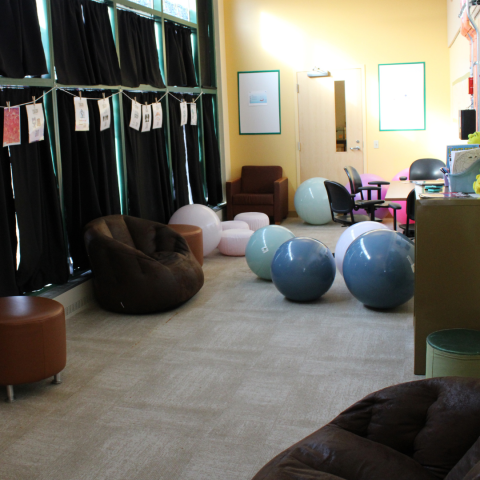The Gwendolyn Brooks Library's Sensory Space: A Trauma-Informed Approach to Health and Wellness
- Log in to post comments

The Gwendolyn Brooks Library at Chicago State University has created a sensory space to promote health and wellness. The library sensory space offers a calming environment for students to decompress, de-stress, and regulate their emotions. This student-centered initiative, which was soft-launched in September of 2024 and officially opened on December 5, 2024, was developed without a university budget and utilized a previously unused "dead space" within the library.
Chicago State University adopted a trauma-informed approach to teaching and engagement, recognizing the unique challenges our students face. As an institution we aim to provide a secure environment that supports the resilience and educational goals of our students amidst their external responsibilities. The library sensory space project aligns with the university's dedication to being a trauma-informed institution serving the needs of our diverse student population, which is 68% African American and predominantly women. The library's goal was to create a universally accessible space that enhances student well-being and academic success by reducing anxiety and improving cognitive function.
The Gwendolyn Brooks Library Sensory Space is an inclusive initiative that ensures accessibility and equity for all students, regardless of background, neurodiversity, or learning needs. By offering a space designed to accommodate students with sensory sensitivities, we actively promote a culture of belonging and respect within the university community.
This space was created with zero university funds, and the materials were sourced through repurposing existing furniture and generous donations from the Library and Instruction Services staff. The project exemplifies how a community effort can create positive transformational experiences for students while adhering to budgetary constraints.
The Four Rs of Health and Wellness
The concept for the sensory space is based on the "four Rs" of health and wellness: Relax, Release, Rest, and Reset. This model was inspired by my experiences as parent of a neurodiverse student while they were attending university. The four Rs are a cycle that can help students manage stress and anxiety and was beneficial for my college student.
- Relax: Students can take a moment to relax when they feel overwhelmed, stressed, or unable to focus. The sensory space provides aromatherapy bottles and essential oils that can reduce stress and anxiety, improve mood, and promote better sleep. Disposable earplugs are available for students who may need to reduce auditory stimulation to relax.
- Release: The sensory space encourages students to release stress and tension. Activities like journaling, which involve writing or drawing on sticky notes or in provided notebooks, can help students express themselves and expunge negative feelings. Arts and crafts, such as coloring with pencils or gel pens, are also available as a way to relieve anxiety.
- Rest: Students are encouraged to rest their minds, bodies, and spirits. The space offers yoga mats, floor cushions, and bean bag chairs for taking a power naps and meditation.
- Reset: After resting, students can feel refreshed and renewed, ready to tackle the challenges of university life and their course work. The sensory space provides activities like word searches, crossword puzzles, and graphic novels to help students regain focus and engage their brains.
The library offers various activities and resources within the sensory space. Fidget spinners, stress balls, and textured toys are available for everyone to use. A Libguide dedicated to the sensory space provides suggestions for activities based on the student’s current emotional state and needs. The Libguide includes links to an online collection of materials related to mental health awareness, a curated selection of mental health eBooks, and the University Counseling Center. The sensory space contains a small collection of graphic novels and fiction books that are not part of the library's main collection and are free for students to take. The sensory space includes a "little book of love" where students, faculty, and staff can leave encouraging notes for one another as a form of community building.
Universal Access and Student-Centered Design
The sensory space was designed with universal access principles in mind, which means it was created to meet the needs of the widest possible audience, not just those with disabilities or who are neurodiverse. The sensory space supports highly sensitive learners who need access to a physical environment with reduced sensory stimuli from light and noise. The space is self-guided, allowing students to use it as they see fit, and it is governed by a simple rule: respect others' needs. The sensory space is open to the entire campus community (students, staff, and faculty) during the library’s hours of operation.
The space also serves as a haven for students who are parents and caregivers, offering a place where they can study while their children read, play, or nap. This is especially important for the university's student body, which includes many students who are often juggling parenting, caregiving, and full-time work.
The project's ongoing development incorporates feedback from students, including those with disabilities and campus partners to ensure the space continues to meet our students’ needs.
Conclusion
The sensory space at the Gwendolyn Brooks Library is a testament to the dedication of Chicago State University's faculty and staff to student well-being. By transforming an unused space into a health and wellness hub, the library has created a supportive environment that addresses the unique needs of our student population. The success of the space is reflected in its positive reception by students, including incoming first-year students and transfer students, who appreciate the library's commitment to their mental health and academic success. The initiative demonstrates that a library can be more than just a quiet place for books; it can be a dynamic hub for collaboration, learning, and holistic self-care.
This week’s blog post was written by April Hummons, Assistant Professor & Systems Librarian, Gwendolyn Brooks Library, Chicago State University.
